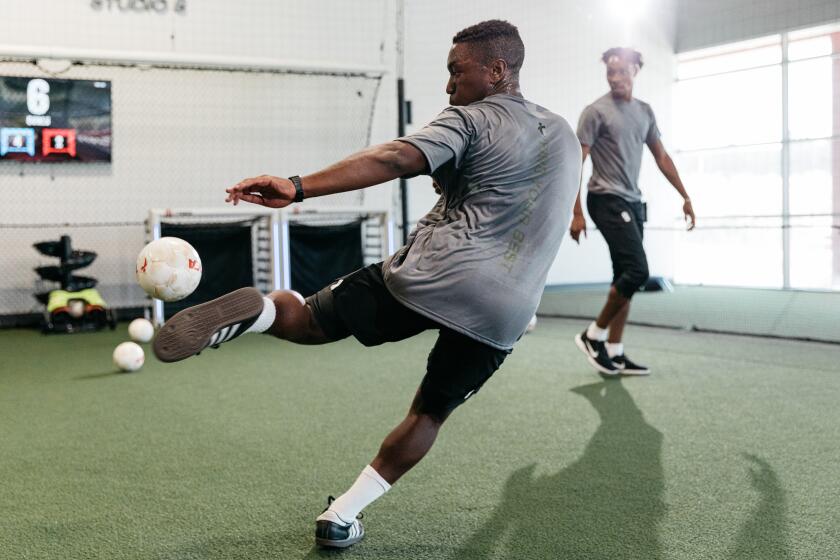U.S. soccer team shines with Michael Bradley in diamond formation

Juergen Klinsmann hasn’t made many missteps in his 2 1/2 years of coach of the U.S. national team. Still it was hard not to question last week’s decision to jettison Martin Vasquez, his longtime right-hand man, and replace him with Tab Ramos and former German national team coach Berti Vogts.
Sacking your top assistant two months before the World Cup is a little like a presidential candidate dumping his running mate after the convention. So was it an act of panic or prescience?
It’s too early to tell. But the early returns are promising.
Vazquez had reportedly lost the ear of the national team’s players, which probably made the move necessary. Vogts is one of the most experienced managers in international soccer, which made the late timing work.
And if any of that inspired Klinsmann’s change in strategy ahead of last Wednesday’s friendly with Mexico, the change may ultimately prove to be a brilliant one.
Against Mexico, the U.S. discarded the 4-2-3-1 formation Klinsmann has long favored for a more conventional 4-4-2 alignment. He also moved Michael Bradley, who has quietly — and unquestionably — become the best player for the U.S. from a defensive position to the tip of a midfield diamond.
For the first 45 minutes, Bradley was unstoppable, scoring one goal, setting up another and basically dominating play. Mexico neutralized Bradley in the second half by flooding the midfield, leading to the two scores that allowed it to escape with a 2-2 draw.
After discovering their diamond in the rough, however, the U.S. was ready to call the tie a big win.
“Every coach always tries to see where are the strengths of each one of those guys,” Klinsmann said. “Michael has tremendous strength, finding ways, getting in the box and joining the attack. So purposely we moved him.”
The new formation works to the United States’ advantage in several ways. First it puts Bradley in a playmaking role — on the ball and facing forward — and allows the team to better exploit his passing skills and ability to make runs into open spaces.
That also alleviates pressure up front, where the U.S. has typically struggled in World Cup play. The last time an American striker scored in a World Cup was 2002, and that drought didn’t figure to end this summer with Jozy Altidore — who has one goal in 27 games for Sunderland of the English Premier League — playing as a lone striker. In a 4-4-2, however, Altidore will get a lot of help from a second forward, likely Aron Johannsson, who is far more comfortable in that formation as well.
Finally the diamond also allows Kyle Beckerman to play as a defensive midfielder, the position he has owned for Real Salt Lake of Major League Soccer.
After watching how well it all worked Wednesday, Klinsmann began to sound like a convert.
“The hope was that he gets into the box. The hope was that he is actually also dangerous to score,” the coach said of Bradley, who did both. “Often we had situations where we didn’t give enough support to our forwards. When you especially look at Jozy, often we had kind of him disconnected.
“But if we have two guys to play into up front and Michael joins … it’s going to be more difficult for opponents to read us.”
Whether the credit for that goes to 67-year-old Vogts is less certain. Like Klinsmann, Vogts won a World Cup for Germany before taking over as coach and leading the German team, which included a striker named Klinsmann, to a European championship in 1996.
Vogts also won the admiration and respect of Klinsmann, who tried to hire his former teacher as technical director for Germany ahead of the 2006 World Cup.
“So that’s not a decision made overnight. It goes almost 10 years back,” Klinsmann said of the move to bring Vogts.
Talks with Vogts probably intensified over the last several weeks as U.S. Soccer negotiated with Azerbaijan to schedule a pre-World Cup friendly in San Francisco. Vogts has coached Azerbaijan’s national team since 2008, meaning he’ll be on the opposite sideline for the late May exhibition at Candlestick Park.
In his role as special advisor, Vogts will help Klinsmann develop training plans and scout opponents — with the exception, presumably, of Azerbaijan. He is also, it would seem, advising his former pupil on formations and game strategy. And his appointment continues the Germanification of the U.S. team: The coaching staff already included Klinsmann’s former Bayern Munich teammate Andreas Herzog, while the national team player pool includes at least seven men who were either born in Germany or live there.
As for Vazquez, a former Cal State Los Angeles player who was head coach at Chivas USA in between stints as Klinsmann’s No. 2 at Bayern Munich and with the U.S. national team, the future is less certain. Last month, Kyle Martino, NBC’s lead soccer analyst, foretold of Vazquez’s ouster by saying he was “in over his head” with the national team and was unable to deliver Klinsmann’s message and philosophy to the players.
Speaking before the Mexico match, Klinsmann wouldn’t confirm that. But he didn’t deny it either.
“It’s simply a professional shift,” he said of Vazquez, whose role remains undefined. “I have to make decisions with my staff to put them into the spots where I think they are the best in order to hopefully do well this summer in Brazil. And sometimes it’s a shift that doesn’t please everybody.
“But this is part of the head coach’s role. You are not there to please everybody. You are there to put people hopefully in the best position to get the job done.”
And for Bradley, that position is clearly at the top of a diamond.
Twitter: @kbaxter11







